Business Administration: Problem-Solving Techniques Report
VerifiedAdded on 2021/01/01
|13
|4061
|167
Report
AI Summary
This report delves into the realm of business administration, focusing on problem-solving techniques and continuous improvement strategies. It explores various problem-solving methods, organizational and legal constraints, and the crucial role of stakeholders in the process. The report outlines the steps involved in business decision-making, emphasizing the implications of adopting recommendations and implementing decisions. Furthermore, it examines the purpose and benefits of continuous improvement, including different techniques and models like Kaizen and Six Sigma, and the importance of feedback. The report analyzes the nature, causes, and implications of problems, such as staff disengagement, and proposes courses of action. It highlights the significance of evidence-based approaches, planning, and obtaining approval for solutions, while also addressing the measurement of success and the scale of implications. Finally, the report stresses the importance of feedback from customers and stakeholders and suggests ways to adopt improvements. Overall, the report provides a comprehensive overview of business problem-solving and continuous improvement.
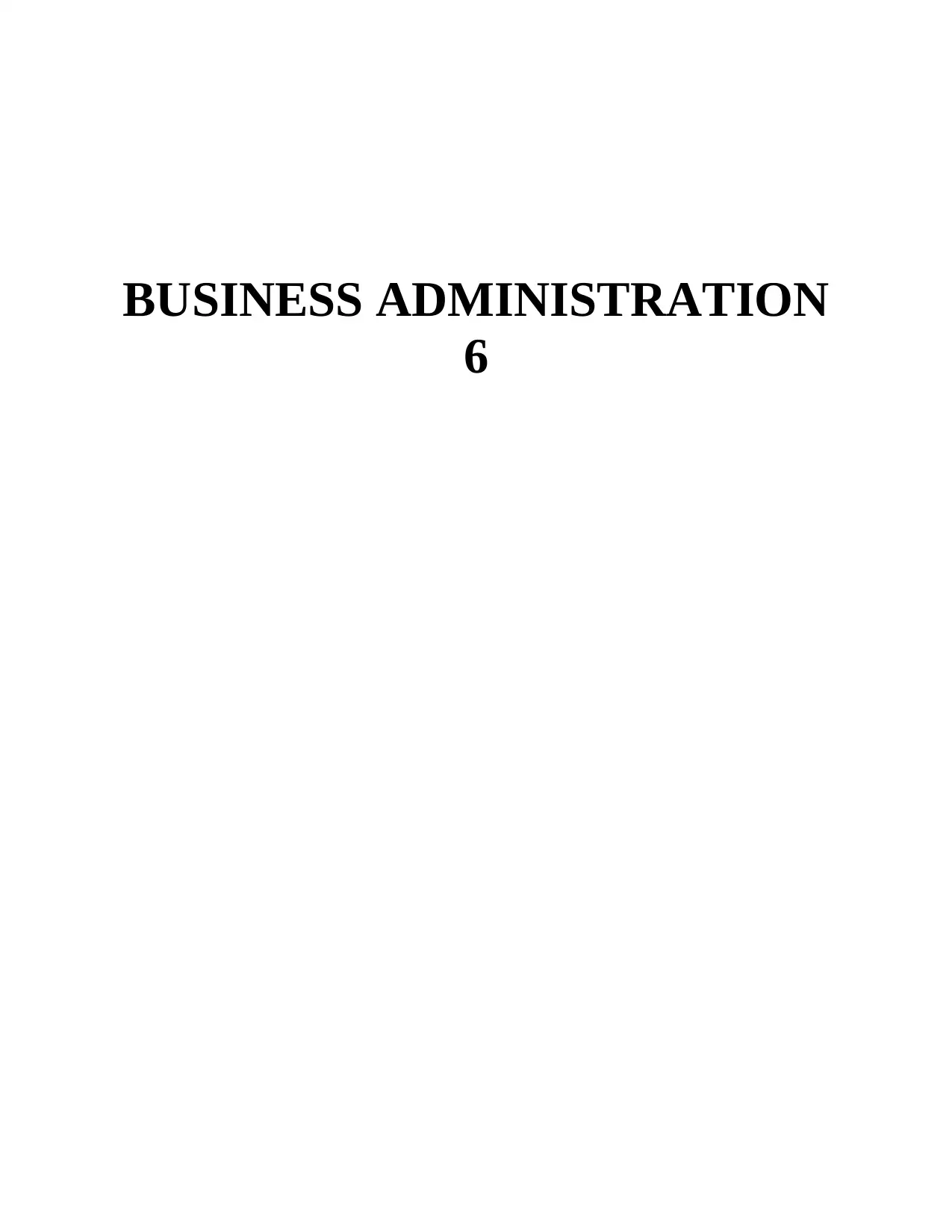
BUSINESS ADMINISTRATION
6
6
Paraphrase This Document
Need a fresh take? Get an instant paraphrase of this document with our AI Paraphraser
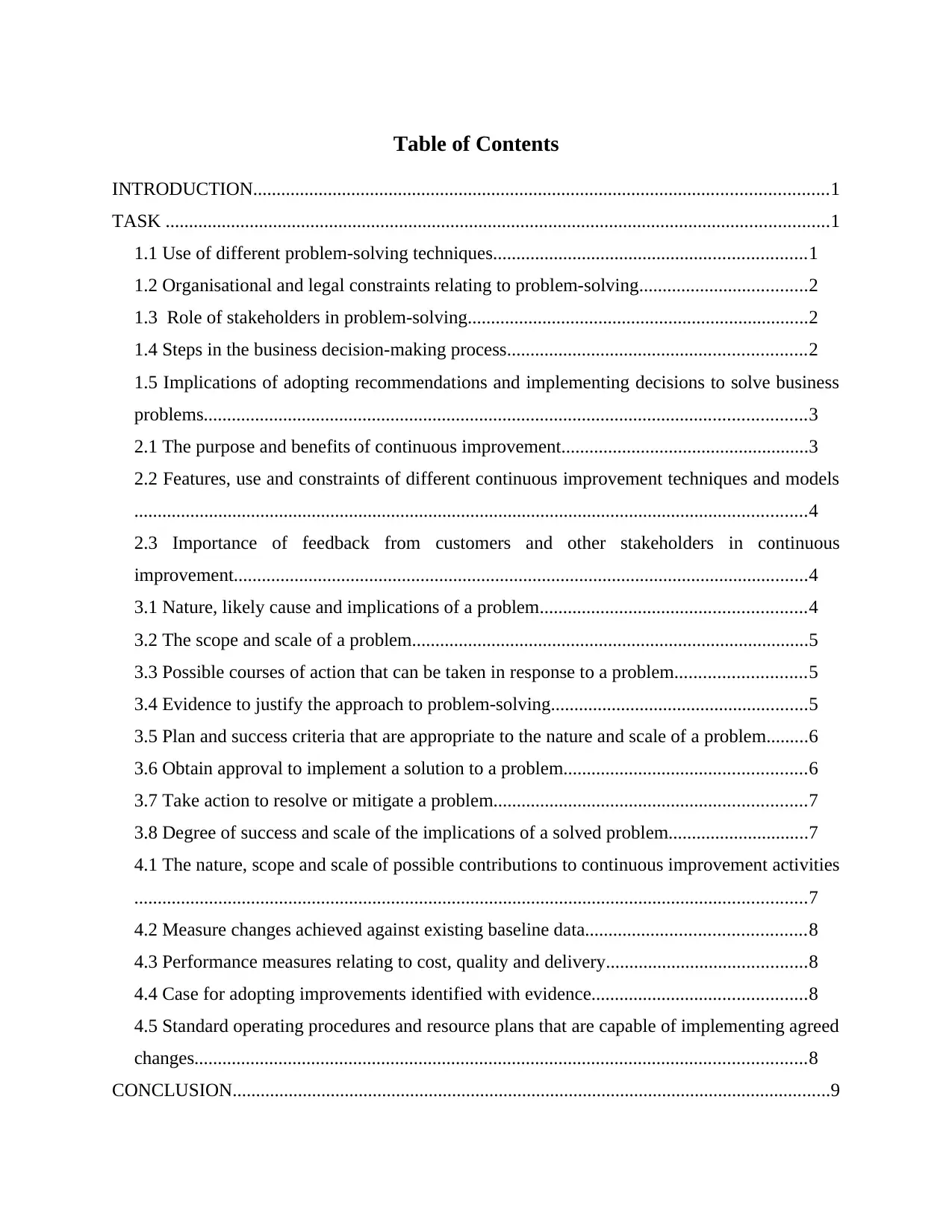
Table of Contents
INTRODUCTION...........................................................................................................................1
TASK ..............................................................................................................................................1
1.1 Use of different problem-solving techniques...................................................................1
1.2 Organisational and legal constraints relating to problem-solving....................................2
1.3 Role of stakeholders in problem-solving.........................................................................2
1.4 Steps in the business decision-making process................................................................2
1.5 Implications of adopting recommendations and implementing decisions to solve business
problems.................................................................................................................................3
2.1 The purpose and benefits of continuous improvement.....................................................3
2.2 Features, use and constraints of different continuous improvement techniques and models
................................................................................................................................................4
2.3 Importance of feedback from customers and other stakeholders in continuous
improvement...........................................................................................................................4
3.1 Nature, likely cause and implications of a problem.........................................................4
3.2 The scope and scale of a problem.....................................................................................5
3.3 Possible courses of action that can be taken in response to a problem............................5
3.4 Evidence to justify the approach to problem-solving.......................................................5
3.5 Plan and success criteria that are appropriate to the nature and scale of a problem.........6
3.6 Obtain approval to implement a solution to a problem....................................................6
3.7 Take action to resolve or mitigate a problem...................................................................7
3.8 Degree of success and scale of the implications of a solved problem..............................7
4.1 The nature, scope and scale of possible contributions to continuous improvement activities
................................................................................................................................................7
4.2 Measure changes achieved against existing baseline data...............................................8
4.3 Performance measures relating to cost, quality and delivery...........................................8
4.4 Case for adopting improvements identified with evidence..............................................8
4.5 Standard operating procedures and resource plans that are capable of implementing agreed
changes...................................................................................................................................8
CONCLUSION................................................................................................................................9
INTRODUCTION...........................................................................................................................1
TASK ..............................................................................................................................................1
1.1 Use of different problem-solving techniques...................................................................1
1.2 Organisational and legal constraints relating to problem-solving....................................2
1.3 Role of stakeholders in problem-solving.........................................................................2
1.4 Steps in the business decision-making process................................................................2
1.5 Implications of adopting recommendations and implementing decisions to solve business
problems.................................................................................................................................3
2.1 The purpose and benefits of continuous improvement.....................................................3
2.2 Features, use and constraints of different continuous improvement techniques and models
................................................................................................................................................4
2.3 Importance of feedback from customers and other stakeholders in continuous
improvement...........................................................................................................................4
3.1 Nature, likely cause and implications of a problem.........................................................4
3.2 The scope and scale of a problem.....................................................................................5
3.3 Possible courses of action that can be taken in response to a problem............................5
3.4 Evidence to justify the approach to problem-solving.......................................................5
3.5 Plan and success criteria that are appropriate to the nature and scale of a problem.........6
3.6 Obtain approval to implement a solution to a problem....................................................6
3.7 Take action to resolve or mitigate a problem...................................................................7
3.8 Degree of success and scale of the implications of a solved problem..............................7
4.1 The nature, scope and scale of possible contributions to continuous improvement activities
................................................................................................................................................7
4.2 Measure changes achieved against existing baseline data...............................................8
4.3 Performance measures relating to cost, quality and delivery...........................................8
4.4 Case for adopting improvements identified with evidence..............................................8
4.5 Standard operating procedures and resource plans that are capable of implementing agreed
changes...................................................................................................................................8
CONCLUSION................................................................................................................................9

REFERENCES..............................................................................................................................10
.......................................................................................................................................................10
.......................................................................................................................................................10
⊘ This is a preview!⊘
Do you want full access?
Subscribe today to unlock all pages.

Trusted by 1+ million students worldwide
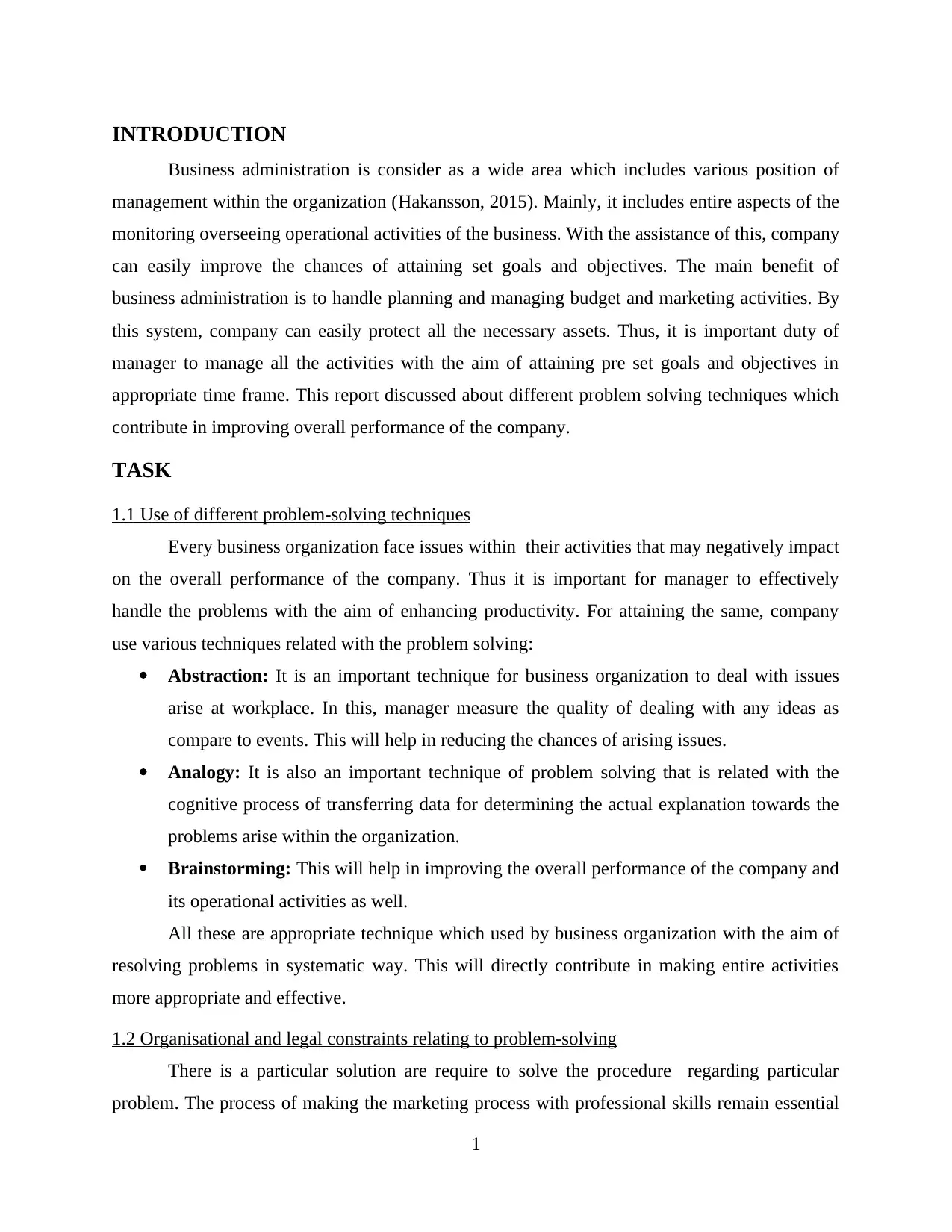
INTRODUCTION
Business administration is consider as a wide area which includes various position of
management within the organization (Hakansson, 2015). Mainly, it includes entire aspects of the
monitoring overseeing operational activities of the business. With the assistance of this, company
can easily improve the chances of attaining set goals and objectives. The main benefit of
business administration is to handle planning and managing budget and marketing activities. By
this system, company can easily protect all the necessary assets. Thus, it is important duty of
manager to manage all the activities with the aim of attaining pre set goals and objectives in
appropriate time frame. This report discussed about different problem solving techniques which
contribute in improving overall performance of the company.
TASK
1.1 Use of different problem-solving techniques
Every business organization face issues within their activities that may negatively impact
on the overall performance of the company. Thus it is important for manager to effectively
handle the problems with the aim of enhancing productivity. For attaining the same, company
use various techniques related with the problem solving:
Abstraction: It is an important technique for business organization to deal with issues
arise at workplace. In this, manager measure the quality of dealing with any ideas as
compare to events. This will help in reducing the chances of arising issues.
Analogy: It is also an important technique of problem solving that is related with the
cognitive process of transferring data for determining the actual explanation towards the
problems arise within the organization.
Brainstorming: This will help in improving the overall performance of the company and
its operational activities as well.
All these are appropriate technique which used by business organization with the aim of
resolving problems in systematic way. This will directly contribute in making entire activities
more appropriate and effective.
1.2 Organisational and legal constraints relating to problem-solving
There is a particular solution are require to solve the procedure regarding particular
problem. The process of making the marketing process with professional skills remain essential
1
Business administration is consider as a wide area which includes various position of
management within the organization (Hakansson, 2015). Mainly, it includes entire aspects of the
monitoring overseeing operational activities of the business. With the assistance of this, company
can easily improve the chances of attaining set goals and objectives. The main benefit of
business administration is to handle planning and managing budget and marketing activities. By
this system, company can easily protect all the necessary assets. Thus, it is important duty of
manager to manage all the activities with the aim of attaining pre set goals and objectives in
appropriate time frame. This report discussed about different problem solving techniques which
contribute in improving overall performance of the company.
TASK
1.1 Use of different problem-solving techniques
Every business organization face issues within their activities that may negatively impact
on the overall performance of the company. Thus it is important for manager to effectively
handle the problems with the aim of enhancing productivity. For attaining the same, company
use various techniques related with the problem solving:
Abstraction: It is an important technique for business organization to deal with issues
arise at workplace. In this, manager measure the quality of dealing with any ideas as
compare to events. This will help in reducing the chances of arising issues.
Analogy: It is also an important technique of problem solving that is related with the
cognitive process of transferring data for determining the actual explanation towards the
problems arise within the organization.
Brainstorming: This will help in improving the overall performance of the company and
its operational activities as well.
All these are appropriate technique which used by business organization with the aim of
resolving problems in systematic way. This will directly contribute in making entire activities
more appropriate and effective.
1.2 Organisational and legal constraints relating to problem-solving
There is a particular solution are require to solve the procedure regarding particular
problem. The process of making the marketing process with professional skills remain essential
1
Paraphrase This Document
Need a fresh take? Get an instant paraphrase of this document with our AI Paraphraser
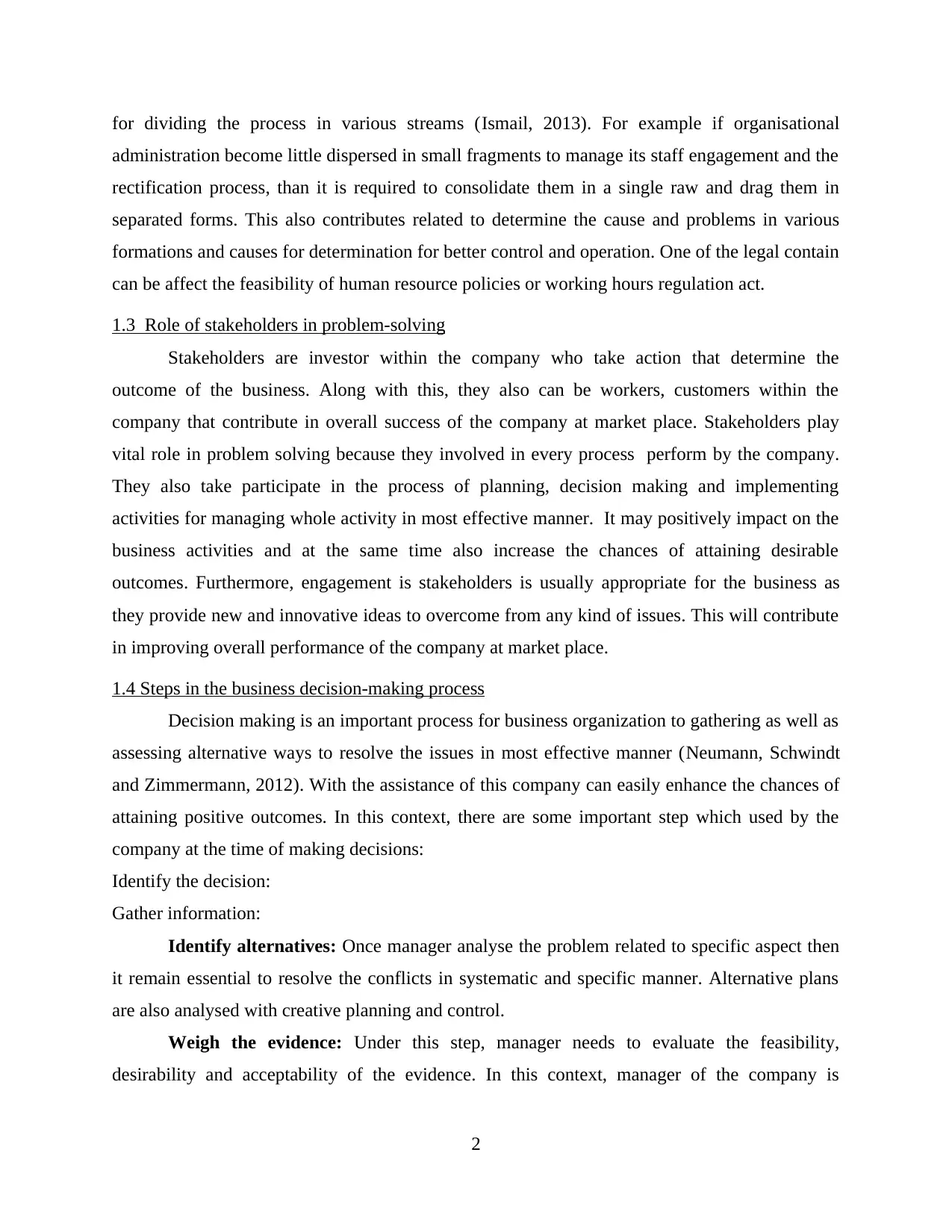
for dividing the process in various streams (Ismail, 2013). For example if organisational
administration become little dispersed in small fragments to manage its staff engagement and the
rectification process, than it is required to consolidate them in a single raw and drag them in
separated forms. This also contributes related to determine the cause and problems in various
formations and causes for determination for better control and operation. One of the legal contain
can be affect the feasibility of human resource policies or working hours regulation act.
1.3 Role of stakeholders in problem-solving
Stakeholders are investor within the company who take action that determine the
outcome of the business. Along with this, they also can be workers, customers within the
company that contribute in overall success of the company at market place. Stakeholders play
vital role in problem solving because they involved in every process perform by the company.
They also take participate in the process of planning, decision making and implementing
activities for managing whole activity in most effective manner. It may positively impact on the
business activities and at the same time also increase the chances of attaining desirable
outcomes. Furthermore, engagement is stakeholders is usually appropriate for the business as
they provide new and innovative ideas to overcome from any kind of issues. This will contribute
in improving overall performance of the company at market place.
1.4 Steps in the business decision-making process
Decision making is an important process for business organization to gathering as well as
assessing alternative ways to resolve the issues in most effective manner (Neumann, Schwindt
and Zimmermann, 2012). With the assistance of this company can easily enhance the chances of
attaining positive outcomes. In this context, there are some important step which used by the
company at the time of making decisions:
Identify the decision:
Gather information:
Identify alternatives: Once manager analyse the problem related to specific aspect then
it remain essential to resolve the conflicts in systematic and specific manner. Alternative plans
are also analysed with creative planning and control.
Weigh the evidence: Under this step, manager needs to evaluate the feasibility,
desirability and acceptability of the evidence. In this context, manager of the company is
2
administration become little dispersed in small fragments to manage its staff engagement and the
rectification process, than it is required to consolidate them in a single raw and drag them in
separated forms. This also contributes related to determine the cause and problems in various
formations and causes for determination for better control and operation. One of the legal contain
can be affect the feasibility of human resource policies or working hours regulation act.
1.3 Role of stakeholders in problem-solving
Stakeholders are investor within the company who take action that determine the
outcome of the business. Along with this, they also can be workers, customers within the
company that contribute in overall success of the company at market place. Stakeholders play
vital role in problem solving because they involved in every process perform by the company.
They also take participate in the process of planning, decision making and implementing
activities for managing whole activity in most effective manner. It may positively impact on the
business activities and at the same time also increase the chances of attaining desirable
outcomes. Furthermore, engagement is stakeholders is usually appropriate for the business as
they provide new and innovative ideas to overcome from any kind of issues. This will contribute
in improving overall performance of the company at market place.
1.4 Steps in the business decision-making process
Decision making is an important process for business organization to gathering as well as
assessing alternative ways to resolve the issues in most effective manner (Neumann, Schwindt
and Zimmermann, 2012). With the assistance of this company can easily enhance the chances of
attaining positive outcomes. In this context, there are some important step which used by the
company at the time of making decisions:
Identify the decision:
Gather information:
Identify alternatives: Once manager analyse the problem related to specific aspect then
it remain essential to resolve the conflicts in systematic and specific manner. Alternative plans
are also analysed with creative planning and control.
Weigh the evidence: Under this step, manager needs to evaluate the feasibility,
desirability and acceptability of the evidence. In this context, manager of the company is
2
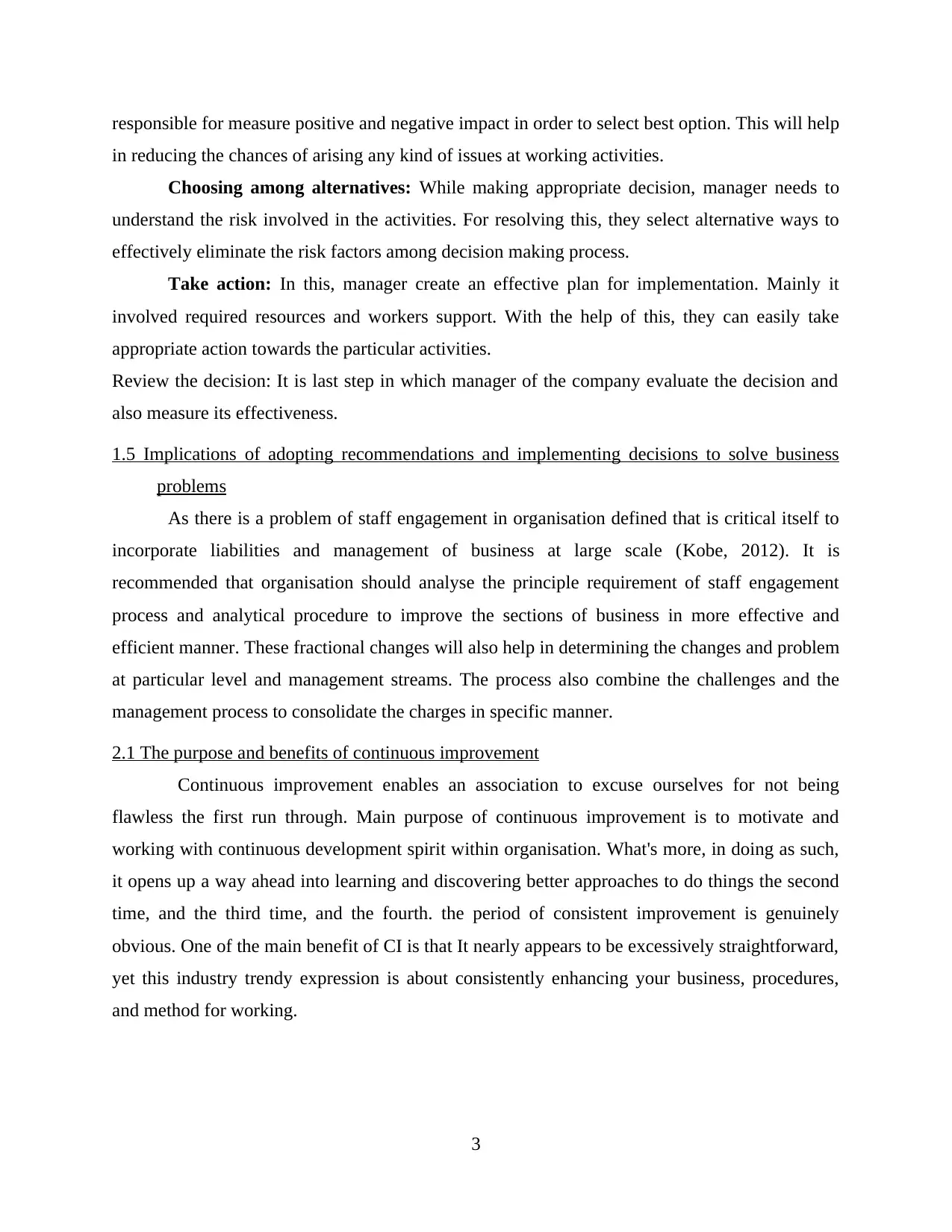
responsible for measure positive and negative impact in order to select best option. This will help
in reducing the chances of arising any kind of issues at working activities.
Choosing among alternatives: While making appropriate decision, manager needs to
understand the risk involved in the activities. For resolving this, they select alternative ways to
effectively eliminate the risk factors among decision making process.
Take action: In this, manager create an effective plan for implementation. Mainly it
involved required resources and workers support. With the help of this, they can easily take
appropriate action towards the particular activities.
Review the decision: It is last step in which manager of the company evaluate the decision and
also measure its effectiveness.
1.5 Implications of adopting recommendations and implementing decisions to solve business
problems
As there is a problem of staff engagement in organisation defined that is critical itself to
incorporate liabilities and management of business at large scale (Kobe, 2012). It is
recommended that organisation should analyse the principle requirement of staff engagement
process and analytical procedure to improve the sections of business in more effective and
efficient manner. These fractional changes will also help in determining the changes and problem
at particular level and management streams. The process also combine the challenges and the
management process to consolidate the charges in specific manner.
2.1 The purpose and benefits of continuous improvement
Continuous improvement enables an association to excuse ourselves for not being
flawless the first run through. Main purpose of continuous improvement is to motivate and
working with continuous development spirit within organisation. What's more, in doing as such,
it opens up a way ahead into learning and discovering better approaches to do things the second
time, and the third time, and the fourth. the period of consistent improvement is genuinely
obvious. One of the main benefit of CI is that It nearly appears to be excessively straightforward,
yet this industry trendy expression is about consistently enhancing your business, procedures,
and method for working.
3
in reducing the chances of arising any kind of issues at working activities.
Choosing among alternatives: While making appropriate decision, manager needs to
understand the risk involved in the activities. For resolving this, they select alternative ways to
effectively eliminate the risk factors among decision making process.
Take action: In this, manager create an effective plan for implementation. Mainly it
involved required resources and workers support. With the help of this, they can easily take
appropriate action towards the particular activities.
Review the decision: It is last step in which manager of the company evaluate the decision and
also measure its effectiveness.
1.5 Implications of adopting recommendations and implementing decisions to solve business
problems
As there is a problem of staff engagement in organisation defined that is critical itself to
incorporate liabilities and management of business at large scale (Kobe, 2012). It is
recommended that organisation should analyse the principle requirement of staff engagement
process and analytical procedure to improve the sections of business in more effective and
efficient manner. These fractional changes will also help in determining the changes and problem
at particular level and management streams. The process also combine the challenges and the
management process to consolidate the charges in specific manner.
2.1 The purpose and benefits of continuous improvement
Continuous improvement enables an association to excuse ourselves for not being
flawless the first run through. Main purpose of continuous improvement is to motivate and
working with continuous development spirit within organisation. What's more, in doing as such,
it opens up a way ahead into learning and discovering better approaches to do things the second
time, and the third time, and the fourth. the period of consistent improvement is genuinely
obvious. One of the main benefit of CI is that It nearly appears to be excessively straightforward,
yet this industry trendy expression is about consistently enhancing your business, procedures,
and method for working.
3
⊘ This is a preview!⊘
Do you want full access?
Subscribe today to unlock all pages.

Trusted by 1+ million students worldwide
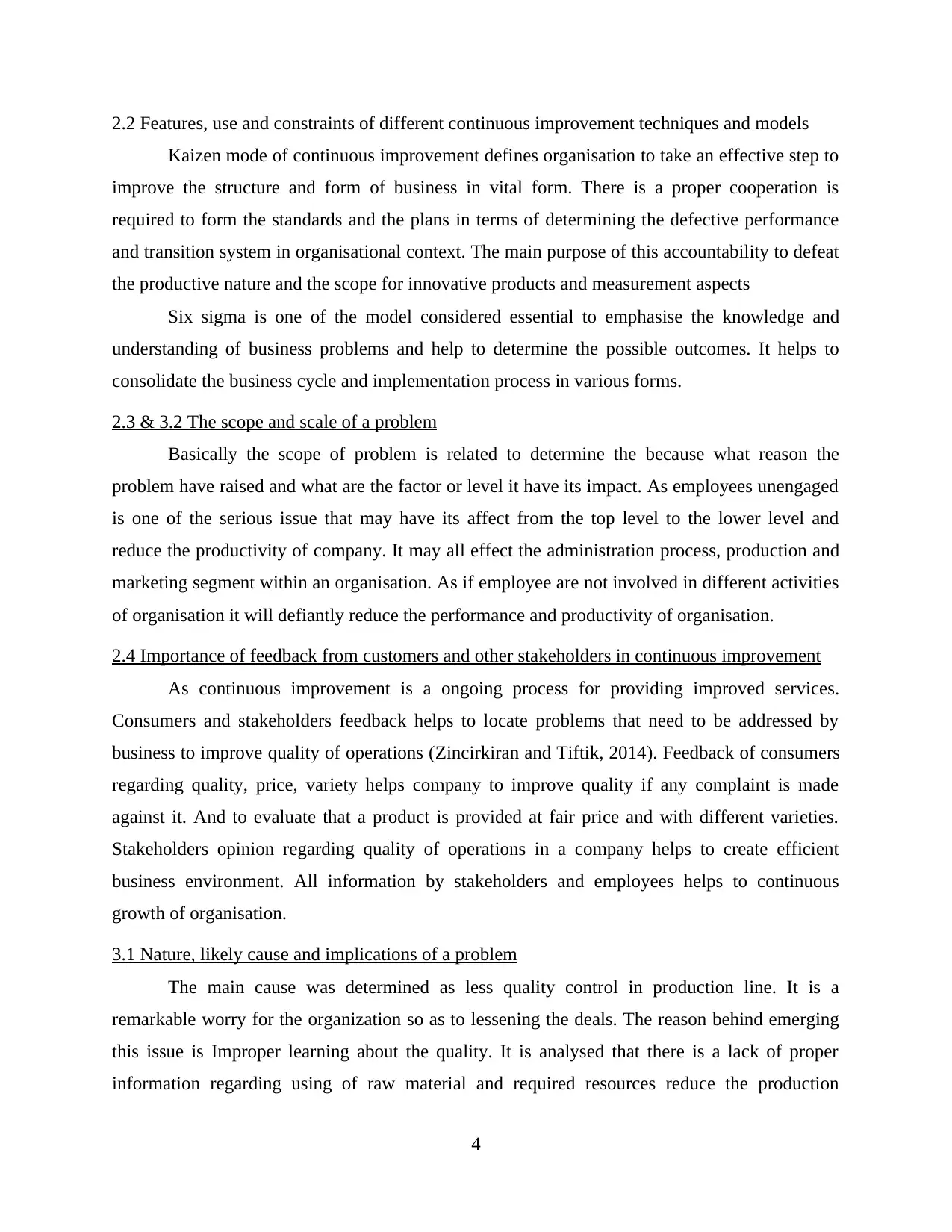
2.2 Features, use and constraints of different continuous improvement techniques and models
Kaizen mode of continuous improvement defines organisation to take an effective step to
improve the structure and form of business in vital form. There is a proper cooperation is
required to form the standards and the plans in terms of determining the defective performance
and transition system in organisational context. The main purpose of this accountability to defeat
the productive nature and the scope for innovative products and measurement aspects
Six sigma is one of the model considered essential to emphasise the knowledge and
understanding of business problems and help to determine the possible outcomes. It helps to
consolidate the business cycle and implementation process in various forms.
2.3 & 3.2 The scope and scale of a problem
Basically the scope of problem is related to determine the because what reason the
problem have raised and what are the factor or level it have its impact. As employees unengaged
is one of the serious issue that may have its affect from the top level to the lower level and
reduce the productivity of company. It may all effect the administration process, production and
marketing segment within an organisation. As if employee are not involved in different activities
of organisation it will defiantly reduce the performance and productivity of organisation.
2.4 Importance of feedback from customers and other stakeholders in continuous improvement
As continuous improvement is a ongoing process for providing improved services.
Consumers and stakeholders feedback helps to locate problems that need to be addressed by
business to improve quality of operations (Zincirkiran and Tiftik, 2014). Feedback of consumers
regarding quality, price, variety helps company to improve quality if any complaint is made
against it. And to evaluate that a product is provided at fair price and with different varieties.
Stakeholders opinion regarding quality of operations in a company helps to create efficient
business environment. All information by stakeholders and employees helps to continuous
growth of organisation.
3.1 Nature, likely cause and implications of a problem
The main cause was determined as less quality control in production line. It is a
remarkable worry for the organization so as to lessening the deals. The reason behind emerging
this issue is Improper learning about the quality. It is analysed that there is a lack of proper
information regarding using of raw material and required resources reduce the production
4
Kaizen mode of continuous improvement defines organisation to take an effective step to
improve the structure and form of business in vital form. There is a proper cooperation is
required to form the standards and the plans in terms of determining the defective performance
and transition system in organisational context. The main purpose of this accountability to defeat
the productive nature and the scope for innovative products and measurement aspects
Six sigma is one of the model considered essential to emphasise the knowledge and
understanding of business problems and help to determine the possible outcomes. It helps to
consolidate the business cycle and implementation process in various forms.
2.3 & 3.2 The scope and scale of a problem
Basically the scope of problem is related to determine the because what reason the
problem have raised and what are the factor or level it have its impact. As employees unengaged
is one of the serious issue that may have its affect from the top level to the lower level and
reduce the productivity of company. It may all effect the administration process, production and
marketing segment within an organisation. As if employee are not involved in different activities
of organisation it will defiantly reduce the performance and productivity of organisation.
2.4 Importance of feedback from customers and other stakeholders in continuous improvement
As continuous improvement is a ongoing process for providing improved services.
Consumers and stakeholders feedback helps to locate problems that need to be addressed by
business to improve quality of operations (Zincirkiran and Tiftik, 2014). Feedback of consumers
regarding quality, price, variety helps company to improve quality if any complaint is made
against it. And to evaluate that a product is provided at fair price and with different varieties.
Stakeholders opinion regarding quality of operations in a company helps to create efficient
business environment. All information by stakeholders and employees helps to continuous
growth of organisation.
3.1 Nature, likely cause and implications of a problem
The main cause was determined as less quality control in production line. It is a
remarkable worry for the organization so as to lessening the deals. The reason behind emerging
this issue is Improper learning about the quality. It is analysed that there is a lack of proper
information regarding using of raw material and required resources reduce the production
4
Paraphrase This Document
Need a fresh take? Get an instant paraphrase of this document with our AI Paraphraser
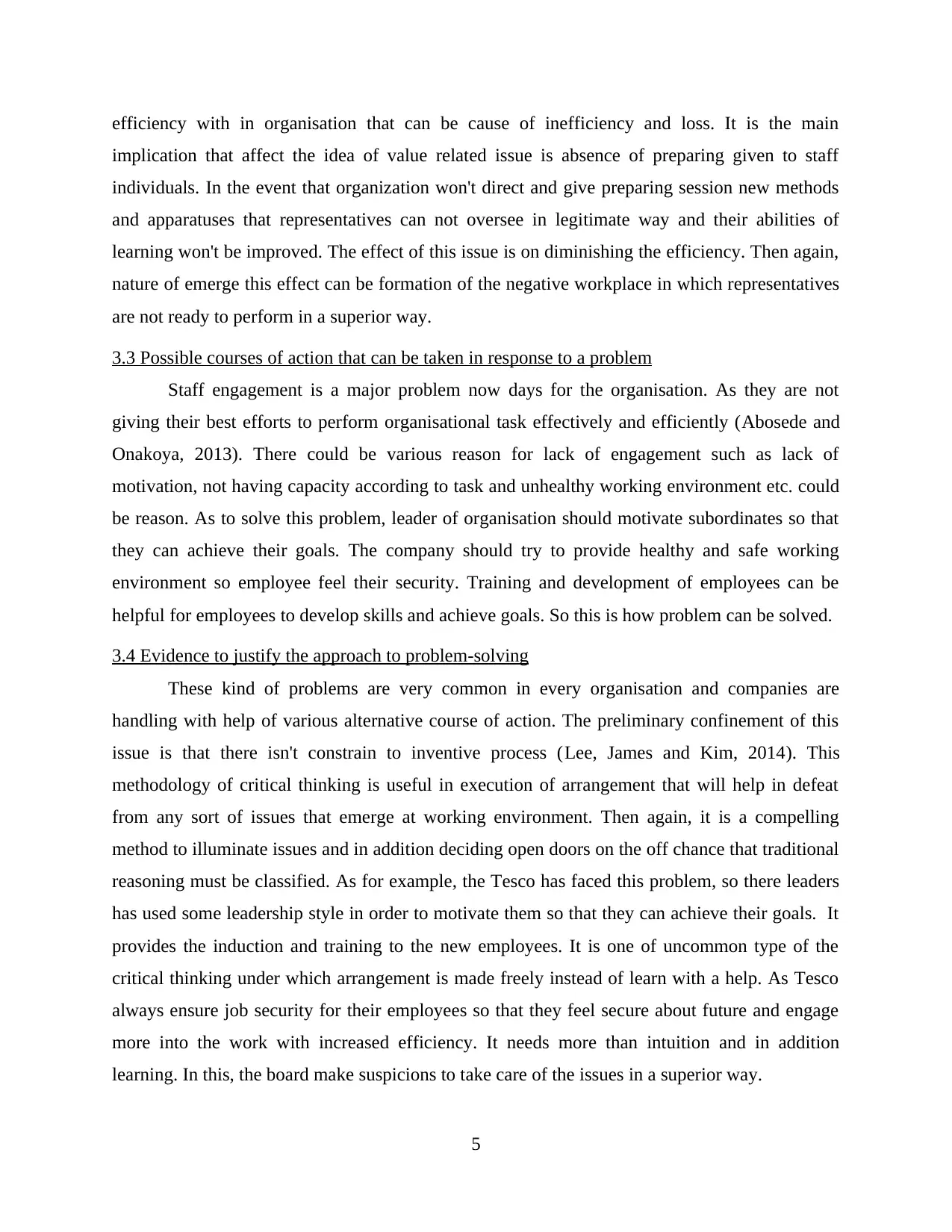
efficiency with in organisation that can be cause of inefficiency and loss. It is the main
implication that affect the idea of value related issue is absence of preparing given to staff
individuals. In the event that organization won't direct and give preparing session new methods
and apparatuses that representatives can not oversee in legitimate way and their abilities of
learning won't be improved. The effect of this issue is on diminishing the efficiency. Then again,
nature of emerge this effect can be formation of the negative workplace in which representatives
are not ready to perform in a superior way.
3.3 Possible courses of action that can be taken in response to a problem
Staff engagement is a major problem now days for the organisation. As they are not
giving their best efforts to perform organisational task effectively and efficiently (Abosede and
Onakoya, 2013). There could be various reason for lack of engagement such as lack of
motivation, not having capacity according to task and unhealthy working environment etc. could
be reason. As to solve this problem, leader of organisation should motivate subordinates so that
they can achieve their goals. The company should try to provide healthy and safe working
environment so employee feel their security. Training and development of employees can be
helpful for employees to develop skills and achieve goals. So this is how problem can be solved.
3.4 Evidence to justify the approach to problem-solving
These kind of problems are very common in every organisation and companies are
handling with help of various alternative course of action. The preliminary confinement of this
issue is that there isn't constrain to inventive process (Lee, James and Kim, 2014). This
methodology of critical thinking is useful in execution of arrangement that will help in defeat
from any sort of issues that emerge at working environment. Then again, it is a compelling
method to illuminate issues and in addition deciding open doors on the off chance that traditional
reasoning must be classified. As for example, the Tesco has faced this problem, so there leaders
has used some leadership style in order to motivate them so that they can achieve their goals. It
provides the induction and training to the new employees. It is one of uncommon type of the
critical thinking under which arrangement is made freely instead of learn with a help. As Tesco
always ensure job security for their employees so that they feel secure about future and engage
more into the work with increased efficiency. It needs more than intuition and in addition
learning. In this, the board make suspicions to take care of the issues in a superior way.
5
implication that affect the idea of value related issue is absence of preparing given to staff
individuals. In the event that organization won't direct and give preparing session new methods
and apparatuses that representatives can not oversee in legitimate way and their abilities of
learning won't be improved. The effect of this issue is on diminishing the efficiency. Then again,
nature of emerge this effect can be formation of the negative workplace in which representatives
are not ready to perform in a superior way.
3.3 Possible courses of action that can be taken in response to a problem
Staff engagement is a major problem now days for the organisation. As they are not
giving their best efforts to perform organisational task effectively and efficiently (Abosede and
Onakoya, 2013). There could be various reason for lack of engagement such as lack of
motivation, not having capacity according to task and unhealthy working environment etc. could
be reason. As to solve this problem, leader of organisation should motivate subordinates so that
they can achieve their goals. The company should try to provide healthy and safe working
environment so employee feel their security. Training and development of employees can be
helpful for employees to develop skills and achieve goals. So this is how problem can be solved.
3.4 Evidence to justify the approach to problem-solving
These kind of problems are very common in every organisation and companies are
handling with help of various alternative course of action. The preliminary confinement of this
issue is that there isn't constrain to inventive process (Lee, James and Kim, 2014). This
methodology of critical thinking is useful in execution of arrangement that will help in defeat
from any sort of issues that emerge at working environment. Then again, it is a compelling
method to illuminate issues and in addition deciding open doors on the off chance that traditional
reasoning must be classified. As for example, the Tesco has faced this problem, so there leaders
has used some leadership style in order to motivate them so that they can achieve their goals. It
provides the induction and training to the new employees. It is one of uncommon type of the
critical thinking under which arrangement is made freely instead of learn with a help. As Tesco
always ensure job security for their employees so that they feel secure about future and engage
more into the work with increased efficiency. It needs more than intuition and in addition
learning. In this, the board make suspicions to take care of the issues in a superior way.
5
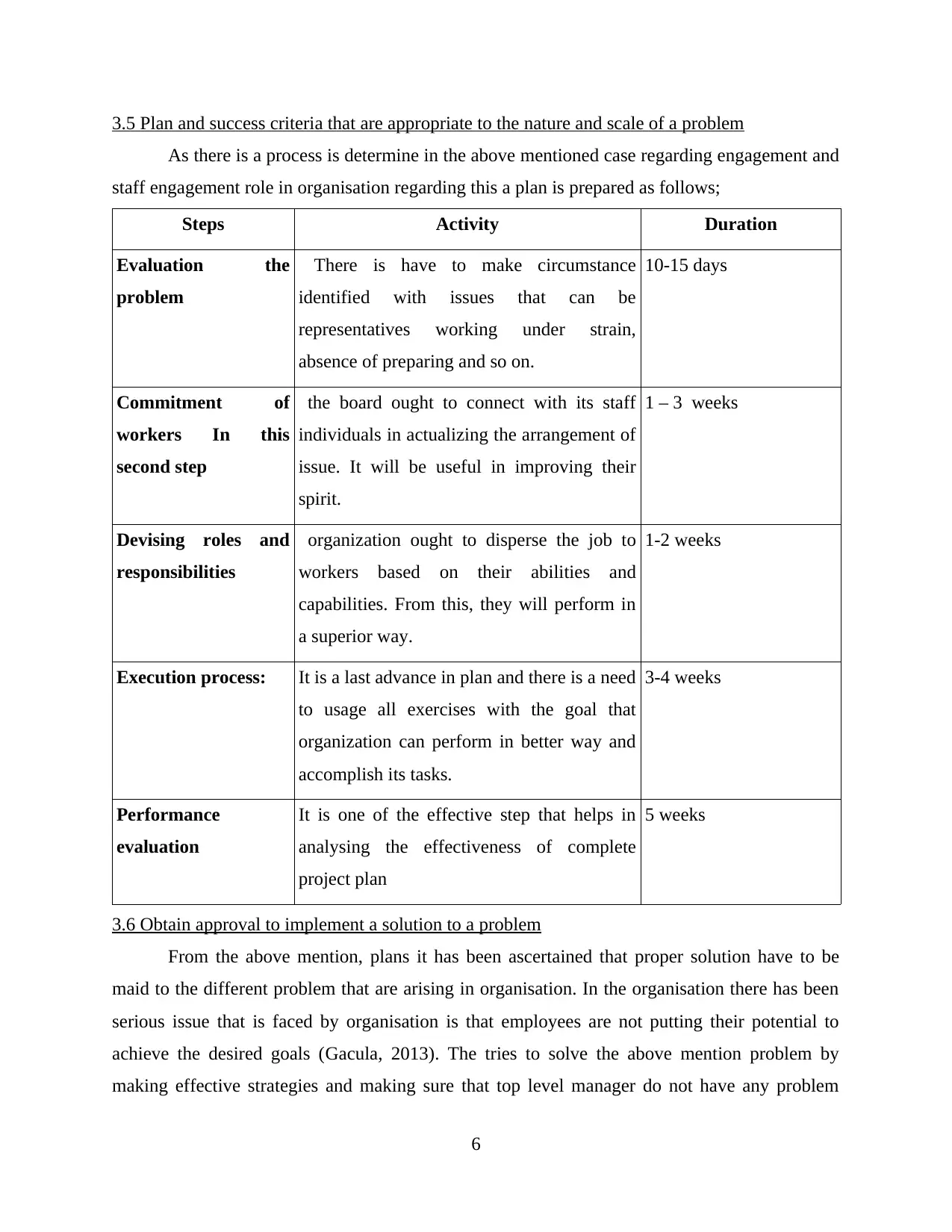
3.5 Plan and success criteria that are appropriate to the nature and scale of a problem
As there is a process is determine in the above mentioned case regarding engagement and
staff engagement role in organisation regarding this a plan is prepared as follows;
Steps Activity Duration
Evaluation the
problem
There is have to make circumstance
identified with issues that can be
representatives working under strain,
absence of preparing and so on.
10-15 days
Commitment of
workers In this
second step
the board ought to connect with its staff
individuals in actualizing the arrangement of
issue. It will be useful in improving their
spirit.
1 – 3 weeks
Devising roles and
responsibilities
organization ought to disperse the job to
workers based on their abilities and
capabilities. From this, they will perform in
a superior way.
1-2 weeks
Execution process: It is a last advance in plan and there is a need
to usage all exercises with the goal that
organization can perform in better way and
accomplish its tasks.
3-4 weeks
Performance
evaluation
It is one of the effective step that helps in
analysing the effectiveness of complete
project plan
5 weeks
3.6 Obtain approval to implement a solution to a problem
From the above mention, plans it has been ascertained that proper solution have to be
maid to the different problem that are arising in organisation. In the organisation there has been
serious issue that is faced by organisation is that employees are not putting their potential to
achieve the desired goals (Gacula, 2013). The tries to solve the above mention problem by
making effective strategies and making sure that top level manager do not have any problem
6
As there is a process is determine in the above mentioned case regarding engagement and
staff engagement role in organisation regarding this a plan is prepared as follows;
Steps Activity Duration
Evaluation the
problem
There is have to make circumstance
identified with issues that can be
representatives working under strain,
absence of preparing and so on.
10-15 days
Commitment of
workers In this
second step
the board ought to connect with its staff
individuals in actualizing the arrangement of
issue. It will be useful in improving their
spirit.
1 – 3 weeks
Devising roles and
responsibilities
organization ought to disperse the job to
workers based on their abilities and
capabilities. From this, they will perform in
a superior way.
1-2 weeks
Execution process: It is a last advance in plan and there is a need
to usage all exercises with the goal that
organization can perform in better way and
accomplish its tasks.
3-4 weeks
Performance
evaluation
It is one of the effective step that helps in
analysing the effectiveness of complete
project plan
5 weeks
3.6 Obtain approval to implement a solution to a problem
From the above mention, plans it has been ascertained that proper solution have to be
maid to the different problem that are arising in organisation. In the organisation there has been
serious issue that is faced by organisation is that employees are not putting their potential to
achieve the desired goals (Gacula, 2013). The tries to solve the above mention problem by
making effective strategies and making sure that top level manager do not have any problem
6
⊘ This is a preview!⊘
Do you want full access?
Subscribe today to unlock all pages.

Trusted by 1+ million students worldwide
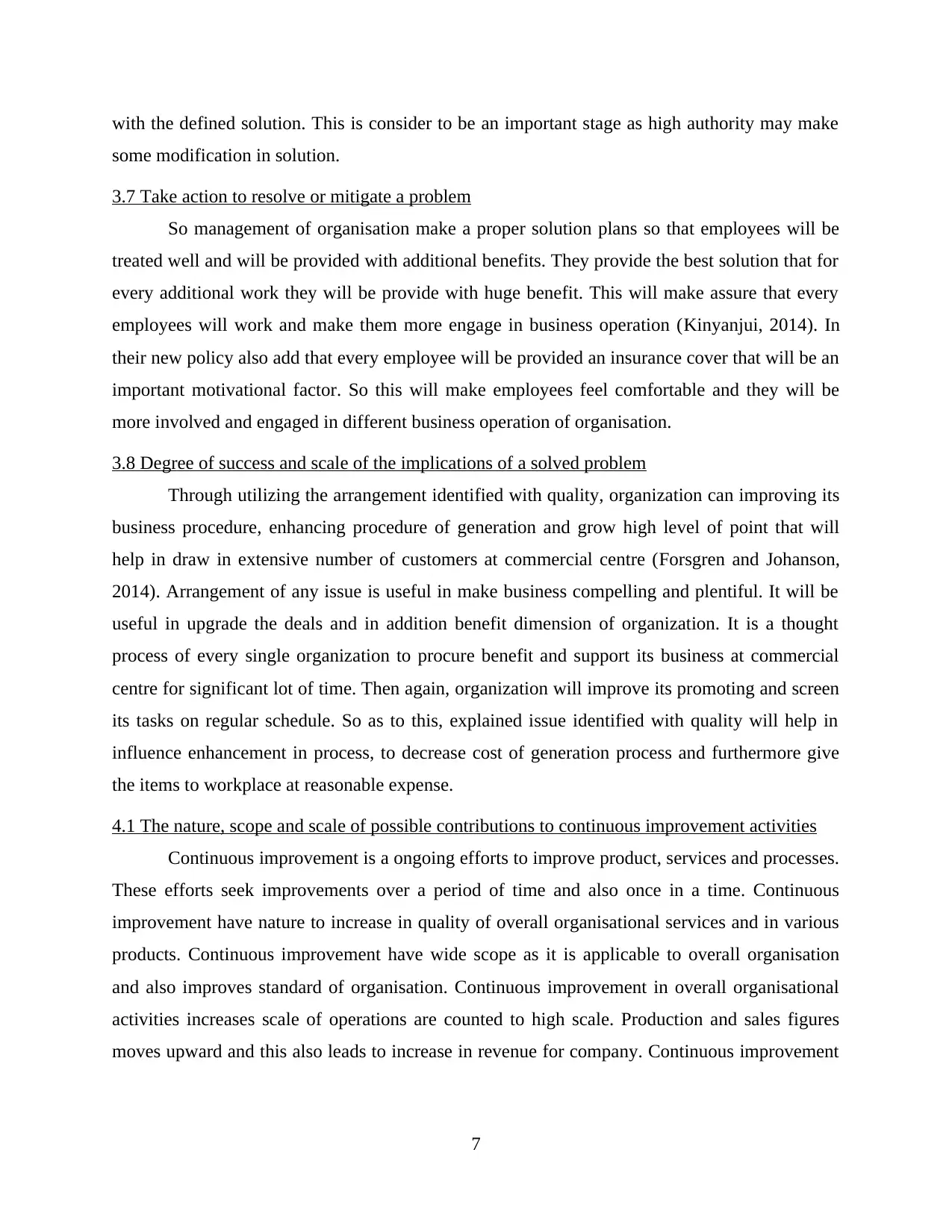
with the defined solution. This is consider to be an important stage as high authority may make
some modification in solution.
3.7 Take action to resolve or mitigate a problem
So management of organisation make a proper solution plans so that employees will be
treated well and will be provided with additional benefits. They provide the best solution that for
every additional work they will be provide with huge benefit. This will make assure that every
employees will work and make them more engage in business operation (Kinyanjui, 2014). In
their new policy also add that every employee will be provided an insurance cover that will be an
important motivational factor. So this will make employees feel comfortable and they will be
more involved and engaged in different business operation of organisation.
3.8 Degree of success and scale of the implications of a solved problem
Through utilizing the arrangement identified with quality, organization can improving its
business procedure, enhancing procedure of generation and grow high level of point that will
help in draw in extensive number of customers at commercial centre (Forsgren and Johanson,
2014). Arrangement of any issue is useful in make business compelling and plentiful. It will be
useful in upgrade the deals and in addition benefit dimension of organization. It is a thought
process of every single organization to procure benefit and support its business at commercial
centre for significant lot of time. Then again, organization will improve its promoting and screen
its tasks on regular schedule. So as to this, explained issue identified with quality will help in
influence enhancement in process, to decrease cost of generation process and furthermore give
the items to workplace at reasonable expense.
4.1 The nature, scope and scale of possible contributions to continuous improvement activities
Continuous improvement is a ongoing efforts to improve product, services and processes.
These efforts seek improvements over a period of time and also once in a time. Continuous
improvement have nature to increase in quality of overall organisational services and in various
products. Continuous improvement have wide scope as it is applicable to overall organisation
and also improves standard of organisation. Continuous improvement in overall organisational
activities increases scale of operations are counted to high scale. Production and sales figures
moves upward and this also leads to increase in revenue for company. Continuous improvement
7
some modification in solution.
3.7 Take action to resolve or mitigate a problem
So management of organisation make a proper solution plans so that employees will be
treated well and will be provided with additional benefits. They provide the best solution that for
every additional work they will be provide with huge benefit. This will make assure that every
employees will work and make them more engage in business operation (Kinyanjui, 2014). In
their new policy also add that every employee will be provided an insurance cover that will be an
important motivational factor. So this will make employees feel comfortable and they will be
more involved and engaged in different business operation of organisation.
3.8 Degree of success and scale of the implications of a solved problem
Through utilizing the arrangement identified with quality, organization can improving its
business procedure, enhancing procedure of generation and grow high level of point that will
help in draw in extensive number of customers at commercial centre (Forsgren and Johanson,
2014). Arrangement of any issue is useful in make business compelling and plentiful. It will be
useful in upgrade the deals and in addition benefit dimension of organization. It is a thought
process of every single organization to procure benefit and support its business at commercial
centre for significant lot of time. Then again, organization will improve its promoting and screen
its tasks on regular schedule. So as to this, explained issue identified with quality will help in
influence enhancement in process, to decrease cost of generation process and furthermore give
the items to workplace at reasonable expense.
4.1 The nature, scope and scale of possible contributions to continuous improvement activities
Continuous improvement is a ongoing efforts to improve product, services and processes.
These efforts seek improvements over a period of time and also once in a time. Continuous
improvement have nature to increase in quality of overall organisational services and in various
products. Continuous improvement have wide scope as it is applicable to overall organisation
and also improves standard of organisation. Continuous improvement in overall organisational
activities increases scale of operations are counted to high scale. Production and sales figures
moves upward and this also leads to increase in revenue for company. Continuous improvement
7
Paraphrase This Document
Need a fresh take? Get an instant paraphrase of this document with our AI Paraphraser
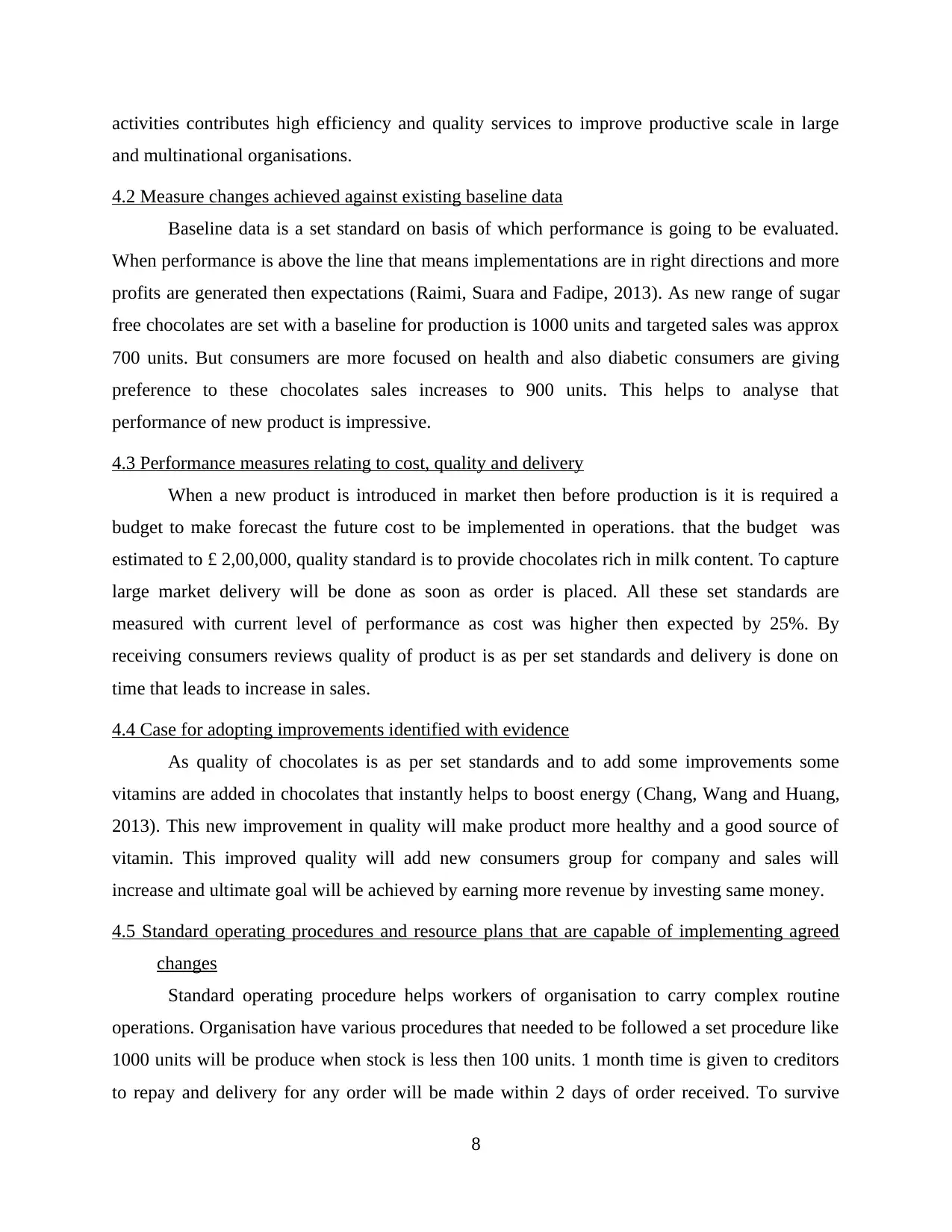
activities contributes high efficiency and quality services to improve productive scale in large
and multinational organisations.
4.2 Measure changes achieved against existing baseline data
Baseline data is a set standard on basis of which performance is going to be evaluated.
When performance is above the line that means implementations are in right directions and more
profits are generated then expectations (Raimi, Suara and Fadipe, 2013). As new range of sugar
free chocolates are set with a baseline for production is 1000 units and targeted sales was approx
700 units. But consumers are more focused on health and also diabetic consumers are giving
preference to these chocolates sales increases to 900 units. This helps to analyse that
performance of new product is impressive.
4.3 Performance measures relating to cost, quality and delivery
When a new product is introduced in market then before production is it is required a
budget to make forecast the future cost to be implemented in operations. that the budget was
estimated to £ 2,00,000, quality standard is to provide chocolates rich in milk content. To capture
large market delivery will be done as soon as order is placed. All these set standards are
measured with current level of performance as cost was higher then expected by 25%. By
receiving consumers reviews quality of product is as per set standards and delivery is done on
time that leads to increase in sales.
4.4 Case for adopting improvements identified with evidence
As quality of chocolates is as per set standards and to add some improvements some
vitamins are added in chocolates that instantly helps to boost energy (Chang, Wang and Huang,
2013). This new improvement in quality will make product more healthy and a good source of
vitamin. This improved quality will add new consumers group for company and sales will
increase and ultimate goal will be achieved by earning more revenue by investing same money.
4.5 Standard operating procedures and resource plans that are capable of implementing agreed
changes
Standard operating procedure helps workers of organisation to carry complex routine
operations. Organisation have various procedures that needed to be followed a set procedure like
1000 units will be produce when stock is less then 100 units. 1 month time is given to creditors
to repay and delivery for any order will be made within 2 days of order received. To survive
8
and multinational organisations.
4.2 Measure changes achieved against existing baseline data
Baseline data is a set standard on basis of which performance is going to be evaluated.
When performance is above the line that means implementations are in right directions and more
profits are generated then expectations (Raimi, Suara and Fadipe, 2013). As new range of sugar
free chocolates are set with a baseline for production is 1000 units and targeted sales was approx
700 units. But consumers are more focused on health and also diabetic consumers are giving
preference to these chocolates sales increases to 900 units. This helps to analyse that
performance of new product is impressive.
4.3 Performance measures relating to cost, quality and delivery
When a new product is introduced in market then before production is it is required a
budget to make forecast the future cost to be implemented in operations. that the budget was
estimated to £ 2,00,000, quality standard is to provide chocolates rich in milk content. To capture
large market delivery will be done as soon as order is placed. All these set standards are
measured with current level of performance as cost was higher then expected by 25%. By
receiving consumers reviews quality of product is as per set standards and delivery is done on
time that leads to increase in sales.
4.4 Case for adopting improvements identified with evidence
As quality of chocolates is as per set standards and to add some improvements some
vitamins are added in chocolates that instantly helps to boost energy (Chang, Wang and Huang,
2013). This new improvement in quality will make product more healthy and a good source of
vitamin. This improved quality will add new consumers group for company and sales will
increase and ultimate goal will be achieved by earning more revenue by investing same money.
4.5 Standard operating procedures and resource plans that are capable of implementing agreed
changes
Standard operating procedure helps workers of organisation to carry complex routine
operations. Organisation have various procedures that needed to be followed a set procedure like
1000 units will be produce when stock is less then 100 units. 1 month time is given to creditors
to repay and delivery for any order will be made within 2 days of order received. To survive
8
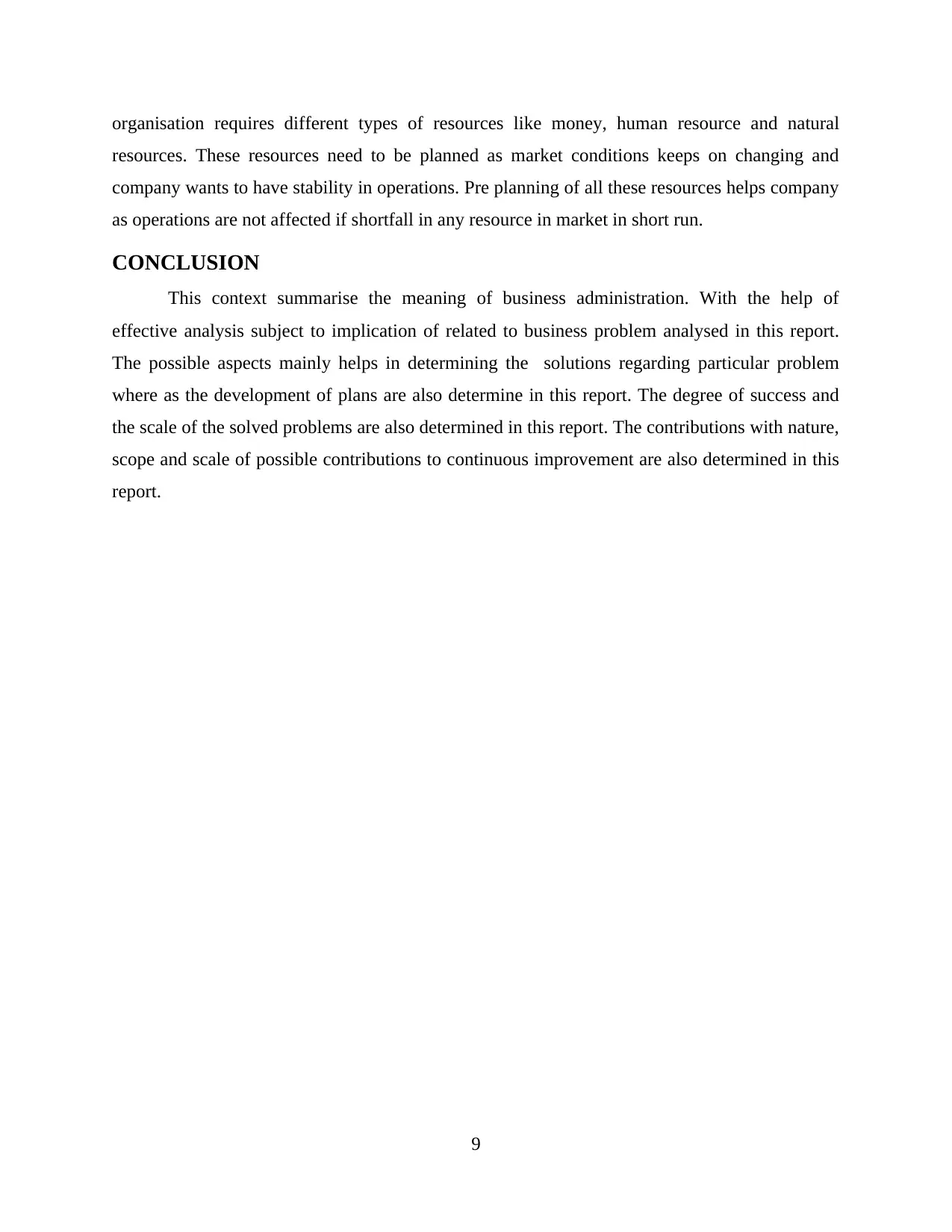
organisation requires different types of resources like money, human resource and natural
resources. These resources need to be planned as market conditions keeps on changing and
company wants to have stability in operations. Pre planning of all these resources helps company
as operations are not affected if shortfall in any resource in market in short run.
CONCLUSION
This context summarise the meaning of business administration. With the help of
effective analysis subject to implication of related to business problem analysed in this report.
The possible aspects mainly helps in determining the solutions regarding particular problem
where as the development of plans are also determine in this report. The degree of success and
the scale of the solved problems are also determined in this report. The contributions with nature,
scope and scale of possible contributions to continuous improvement are also determined in this
report.
9
resources. These resources need to be planned as market conditions keeps on changing and
company wants to have stability in operations. Pre planning of all these resources helps company
as operations are not affected if shortfall in any resource in market in short run.
CONCLUSION
This context summarise the meaning of business administration. With the help of
effective analysis subject to implication of related to business problem analysed in this report.
The possible aspects mainly helps in determining the solutions regarding particular problem
where as the development of plans are also determine in this report. The degree of success and
the scale of the solved problems are also determined in this report. The contributions with nature,
scope and scale of possible contributions to continuous improvement are also determined in this
report.
9
⊘ This is a preview!⊘
Do you want full access?
Subscribe today to unlock all pages.

Trusted by 1+ million students worldwide
1 out of 13
Related Documents
Your All-in-One AI-Powered Toolkit for Academic Success.
+13062052269
info@desklib.com
Available 24*7 on WhatsApp / Email
![[object Object]](/_next/static/media/star-bottom.7253800d.svg)
Unlock your academic potential
Copyright © 2020–2025 A2Z Services. All Rights Reserved. Developed and managed by ZUCOL.





